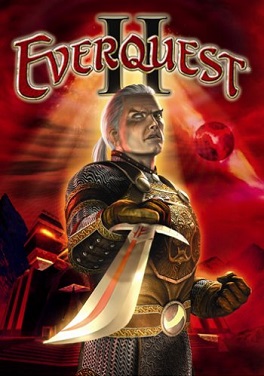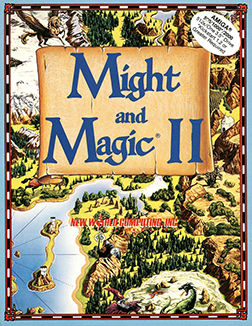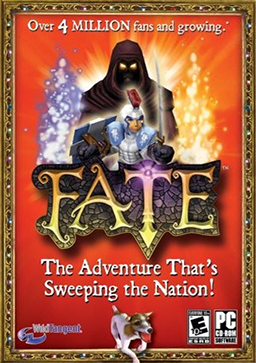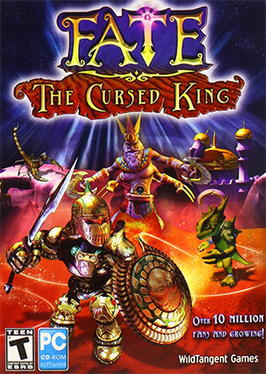
EverQuest is a 3D fantasy-themed massively multiplayer online role-playing game (MMORPG) originally developed by Verant Interactive and 989 Studios for Windows PCs. It was released by Sony Online Entertainment in March 1999 in North America, and by Ubisoft in Europe in April 2000. A dedicated version for Mac OS X was released in June 2003, which operated for ten years before being shut down in November 2013. In June 2000, Verant Interactive was absorbed into Sony Online Entertainment, who took over full development and publishing duties of the title. Later, in February 2015, SOE's parent corporation, Sony Computer Entertainment, sold the studio to investment company Columbus Nova and it was rebranded as Daybreak Game Company, which continues to develop and publish EverQuest.

Warcraft III: The Frozen Throne is the expansion pack for Warcraft III: Reign of Chaos, a real-time strategy video game by Blizzard Entertainment. It was released worldwide on July 1, 2003, for Microsoft Windows and Mac OS X. The Frozen Throne builds upon the story of Reign of Chaos and depicts the events after the main game's conclusion. The single-player unfolds from the perspective of two new protagonists—the Night Elf warden Maiev Shadowsong and the Blood Elf prince Kael'Thas—as well as returning protagonist Arthas Menethil. Additionally, the expansion contains Act I of a separate Horde campaign that is independent from the main storyline with Blizzard releasing Acts II and III via patch in December 2003, taking in player feedback of Act I when developing these chapters.

HeroQuest, is an adventure board game created by Milton Bradley in conjunction with the British company Games Workshop in 1989, and re-released in 2021. The game is loosely based around archetypes of fantasy role-playing games: the game itself was actually a game system, allowing the gamemaster to create dungeons of their own design using the provided game board, tiles, furnishings and figures. The game manual describes Morcar/Zargon as a former apprentice of Mentor, and the parchment text is read aloud from Mentor's perspective. Several expansions have been released, each adding new tiles, traps, artifacts, and monsters to the core system.
AdventureQuest is an online Flash-based single-player role-playing video game started in 2002 and currently developed by Artix Entertainment.

EverQuest II is a 3D fantasy massively multiplayer online role-playing game (MMORPG) originally developed and published by Sony Online Entertainment for Microsoft Windows PCs and released in November 2004. It is the sequel to the original EverQuest, released five years earlier, and features updated graphics and more streamlined gameplay compared to the previous entry, as well as an abundance of voice acting with contributions from actors such as Christopher Lee and Heather Graham. In February 2015, Sony Online Entertainment's parent corporation Sony Computer Entertainment sold it to investment company Inception Acquisitions, where it continues to develop and publish the game under its new name, Daybreak Game Company.

The Bard's Tale II: The Destiny Knight is a fantasy role-playing video game created by Interplay Productions in 1986. It is the first sequel to The Bard's Tale, and the last game of the series that was designed and programmed by Michael Cranford.

Might and Magic II: Gates to Another World is a role-playing video game developed and published by New World Computing in 1988. It is the sequel to Might and Magic Book One: The Secret of the Inner Sanctum.

Realms of Arkania: Star Trail is a computer role-playing game by Attic Entertainment Software based on the German RPG system Das Schwarze Auge. The original German version of the game was released in 1994. Due to the success of its predecessor Realms of Arkania: Blade of Destiny, it was translated to English and released by Sir-Tech in the same year. An expansion, Speech Pack, was released in 1994 for the floppy disk version.

Champions: Return to Arms is an action role-playing game set in the EverQuest universe. It is the sequel to Champions of Norrath and was developed by Snowblind Studios.

Fate is a 2005 single-player action role-playing game originally released for the PC by WildTangent. Fate was released for the PC Steam client on December 12, 2013. Three sequels—titled Fate: Undiscovered Realms, Fate: The Traitor Soul and Fate: The Cursed King—were released in 2008, 2009 and 2011 respectively.

Titan Quest is a 2006 action role-playing game developed by Iron Lore Entertainment and published by THQ for Windows, first physically and then in 2007 through Steam. A mobile port was developed by DotEmu and published in 2016, and versions for PlayStation 4, Xbox One and Nintendo Switch were released in 2018. All these versions were published by THQ Nordic. The story follows a player-created protagonist as they navigate Ancient Greece, Egypt and China on a quest to defeat the Titans after they escape from their ancient prison. The gameplay is similar to the Diablo series, with player navigation being handled with a mouse-driven tile-based interface, and gameplay revolving around role-playing mechanics and real-time combat. Four expansions have been created for the game; Titan Quest: Immortal Throne in 2007, and three others between 2017 and 2021.

Drakensang: The Dark Eye is a 2008 role-playing video game developed by Radon Labs and published by dtp. It is the first video game in The Dark Eye universe since Attic's Northlands Trilogy from the 1990s. it was followed by the prequel River of Time, which also received an expansion Phileasson's Secret. all of them were put in a collection that is referred as the Drakensang Saga.

Orcs & Elves is an adventure role-playing video game for the mobile phone and Nintendo DS. It was developed by id Software and Fountainhead Entertainment and published by EA Mobile and licensed by Nintendo for the DS version. It was released for mobile phones in May 2006 before being ported to the Nintendo DS in November 2007. The game is based on Doom RPG's engine and is id's first original intellectual property since Quake. The DS port of the game included graphical enhancements, such as 3D environments and camera cutscenes, along with improved character sprites, two new levels and the use of the touchscreen feature.

Nineteen full expansions for the MMORPG EverQuest II have been released, as well as three Adventure Packs.
World of Warcraft, or WoW, is set in a fictional universe, its primary setting being the planet of Azeroth. The first expansion, The Burning Crusade, introduced a second planet, Outland. Wrath of the Lich King and Cataclysm expanded upon Azeroth and respectively added Northrend, the frigid northern continent of Azeroth, and drastically changed various other continents by destroying some and unveiling new ones. The next expansion, Mists of Pandaria, added Pandaria, the southern continent previously hidden behind a perennial mist cover. Warlords of Draenor introduced the planet of Draenor, a version of Outland in a different timeline before its partial destruction. The Legion expansion took adventurers to the Broken Isles, an island chain near the Maelstrom in the middle of the Great Sea, and the damaged planet Argus, the headquarters of the Burning Legion. The seventh expansion, Battle for Azeroth, added two new island continents to the center of Azeroth: Kul Tiras and Zandalar. The latest expansion, Shadowlands, introduced the eponymous Shadowlands, a realm composed of five major zones: Bastion, Maldraxxus, Ardenweald, Revendreth, and the Maw.

Fate: The Traitor Soul is an action role-playing video game developed by WildTangent and released on September 9, 2009, as the second standalone expansion to the 2005 PC game, Fate, with the first one being Fate: Undiscovered Realms released in 2008. It was followed by Fate: The Cursed King in 2011.

The Lord of the Rings: War in the North is a 2011 action role-playing hack and slash video game developed by Snowblind Studios and published by Warner Bros. Interactive Entertainment for PlayStation 3, Xbox 360, and Microsoft Windows. An OS X port was developed and published by Feral Interactive in 2013. It is the first video game based on both J. R. R. Tolkien's 1954 high fantasy novel The Lord of the Rings and Peter Jackson's film trilogy adaptation released in 2001, 2002 and 2003. This is because, until 2009, Vivendi Universal Games, in partnership with Tolkien Enterprises, held the rights to make games based on Tolkien's literary works, whilst Electronic Arts held the rights to make games based on the New Line Cinema films. In 2009, WB Games acquired the rights for both intellectual properties.

Fate: The Cursed King is an action role-playing computer game that was developed and published by WildTangent and has been available to play online since 2011. In 2014, it became available for purchase on Steam. The game follows the Fate series, and is the final in the series.

Marvel Contest of Champions is a 2014 fighting video game developed and published by Kabam. It was released on December 10, 2014, for iOS and Android. The fighting game is primarily set in the Marvel Universe. The game is strongly based on the events of the limited comic book series Contest of Champions. An arcade version was released in 2019, developed by Raw Thrills and exclusive to Dave & Buster's locations.

Thirty full expansions for the MMORPG EverQuest have been released. Initially, expansions were shipped in boxes to stores, but were later put for sale on digital marketplaces. The retail versions often come packaged with a bonus feature such as a creature that the player can put in their in-game house.


















